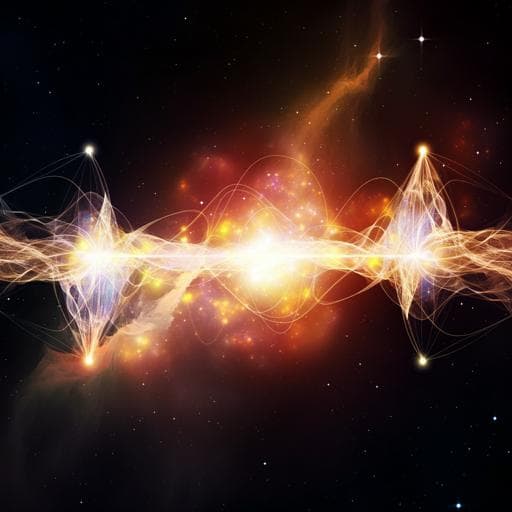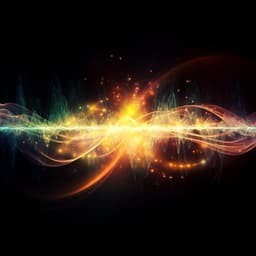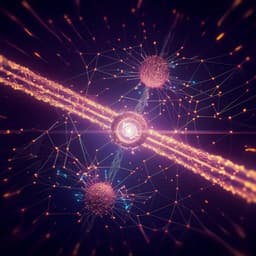
Physics
Hertz-rate metropolitan quantum teleportation
S. Shen, C. Yuan, et al.
Discover groundbreaking research by Si Shen and colleagues demonstrating a quantum teleportation system that achieves a remarkable transfer rate of 7.1 ± 0.4 Hz over 64 kilometers of fiber channel. With single-photon fidelity exceeding the classical limit, this study paves the way for advancements in quantum networks and the future of quantum internet applications.
~3 min • Beginner • English
Introduction
Quantum teleportation enables the ‘disembodied’ transfer of an unknown quantum state to a remote location by using quantum entanglement with the help of quantum measurement and classical communication. It is crucial for quantum networks and distributed quantum computation. Since Bennett et al. (1993), teleportation has been demonstrated across platforms: atomic ensembles, single atoms, trapped ions, solid-state systems, nuclear magnetic resonance, and quantum optics. Optical implementations exist in continuous-variable (CV) and discrete-variable (DV) regimes. CV experiments have achieved deterministic teleportation of coherent and nonclassical states, but distances are limited to around ten kilometers due to fragility under channel loss. For global-scale quantum networks, DV teleportation is preferred and has been realized from meters to over a thousand kilometers, including satellite-based demonstrations over 1200 km. Despite these advances, a high-rate teleportation system suitable for metropolitan fiber networks remains lacking.
Here the authors report an experimental realization of a Hertz-rate quantum teleportation system through fiber over a metropolitan range. Using a high-performance time-bin entangled source based on a fiber-pigtailed PPLN waveguide and an independent weak-coherent single-photon source with decoy states, they ensure indistinguishability after distribution with a fully running feedback system. They teleport photonic time-bin qubits at 7.1 ± 0.4 Hz over an effective 64 km fiber channel with average single-photon fidelity ≥90.6 ± 2.6%, surpassing the classical limit of 2/3.
Literature Review
The paper situates its work within prior demonstrations of quantum teleportation across multiple physical platforms. In optics, CV teleportation has enabled deterministic transfer of coherent and nonclassical states but is constrained to ~10 km due to loss sensitivity. DV teleportation has progressed from table-top to real-world and satellite links, including 1200 km via the Micius satellite. However, prior metropolitan fiber demonstrations lacked high-rate operation with independent photon sources compatible with network architectures. The work addresses this gap by combining time-bin encoding, integrated-waveguide entanglement sources, and active stabilization for indistinguishability over long fibers.
Methodology
Three-node fiber network (Alice, Bob, Charlie) over the UESTC campus backbone dark fibers. Alice (switching room) prepares weak coherent single-photon pulses at 1549.16 nm using a CW laser modulated into 65-ps pulses at 500 MHz via an intensity modulator, synchronized to Bob’s clock over a classical channel. Time-bin qubits are generated using an unbalanced Mach–Zehnder interferometer (UMZI1) with 625 ps path difference, then spectrally filtered by a 10-GHz FBG and attenuated to single-photon level before transmission to Charlie through a 22 km quantum channel (QC_AC; 2 km field-deployed fiber + 20 km spool; 6.8 dB loss).
Bob generates time-bin entangled photon pairs using a 1540.56 nm CW laser modulated into two pump pulses 625 ps apart. After polarization alignment and amplification (EDFA), cascaded second-order nonlinear processes in a fiber-pigtailed PPLN waveguide produce entangled signal (1531.87 nm) and idler (1549.16 nm) photons. Spectral separation uses DWDMs and FBGs (signal 125 GHz FWHM; idler 10 GHz). Mean photon-pair number n_ppc = 0.042. Idler photons travel to Charlie over QC_BC (22 km; 6.4 dB loss; 2 km field fiber + 20 km spool). Signal photons are delayed at Bob in a 20 km fiber spool, then analyzed by UMZI2 (625 ps delay), detected by SNSPDs (80% efficiency, 2.2 K), and time-tagged (TDC).
Charlie performs Bell-state measurement (BSM) using a 50:50 fiber BS and two SNSPDs (60% efficiency), projecting onto |ψ−⟩ by detecting one photon in each output with a 625 ps time difference. Successful BSM results are sent to Bob over classical channel to apply the corresponding unitary (σ_y for |ψ−⟩ outcome) on the stored signal photon to recover the teleported state. System-wide synchronization uses classical optical pulses and AWGs/DFB lasers/PDs.
Indistinguishability is ensured via single-mode fibers, matched FBG filtering, and active stabilization of arrival time and polarization on both QC_AC and QC_BC. Timing and polarization feedback signals (FPGA/DAC) drive optical variable delay lines (OVDLs) and polarization tracker modules (PTMs). Optical isolators (~55 dB) protect against back reflections/attacks. All spools are G.655 NZ-DSF. Prior to teleportation, entanglement distribution quality is verified via Franson interferometry. HOM interference between Alice’s and Bob’s photons at Charlie quantifies indistinguishability. Teleportation tests include equatorial superpositions (via UMZIs) and pole states (single temporal modes), with three-fold coincidences conditioned on BSMs. Quantum state tomography (QST) is performed on |e⟩, |l⟩, |+⟩, and |+i⟩ states. Decoy state method (DSM) is used to estimate single-photon teleportation fidelity given weak-coherent inputs.
Key Findings
- Achieved metropolitan fiber quantum teleportation of time-bin qubits at a rate of 7.1 ± 0.4 Hz over an effective 64 km fiber channel (22 km QC_AC + 22 km QC_BC + 20 km signal storage spool), excluding 6.25 dB extra measurement loss.
- Average single-photon fidelity estimated via decoy state method: ≥90.6 ± 2.6%, exceeding the classical limit of 2/3.
- Direct teleportation performance: equatorial-state interference visibilities 61.4 ± 4.0% and 60.0 ± 3.9%, implying F_equator = (1+V)/2 ≈ 80.4 ± 2.0%; pole-basis fidelities F_e = 92.2 ± 1.0% and F_l = 92.4 ± 1.1%, yielding average fidelity F_avg = (4F_equator + F_e + F_l)/6 = 84.3 ± 1.7% without background subtraction.
- Quantum state tomography on |e⟩, |l⟩, |+⟩, |+i⟩ yields fidelities all above 2/3; average tomography fidelity F_avg = (2(F_+ + F_+i) + F_e + F_i)/6 = 86.4 ± 4.5%.
- Prior entanglement distribution over 42 km (20 km storage + 22 km link) maintained high quality: Franson two-photon interference visibilities 94.3 ± 0.1% and 93.5 ± 0.1%.
- HOM interference at Charlie between independently generated photons after fiber transmission had visibility 35.3 ± 1.0% (near the 40% upper bound for coherent–thermal interference), corresponding to single-photon indistinguishability of 88.8 ± 2.4%.
- Active timing and polarization feedback stabilized arrival times and polarization over hours, enabling reliable BSMs and sustained operation.
Discussion
The study addresses the need for high-rate, long-distance quantum teleportation compatible with metropolitan fiber networks and independent photon sources. By combining a high-brightness time-bin entangled source, narrowband spectral filtering, and active feedback for timing and polarization, the system achieves high indistinguishability at the BSM node and maintains entanglement integrity over tens of kilometers. The observed teleportation fidelities surpass the classical limit and, when accounting for single-photon contributions via the decoy state method, reach ≥90.6%, demonstrating faithful state transfer at hertz rates. These results validate the feasibility of integrating teleportation into practical network architectures, where independent users (Alice) and entanglement providers (Bob) are connected via existing dark-fiber infrastructures. The methods generalize to broader quantum-network scenarios, enabling entanglement-based applications such as quantum repeaters, distributed sensing, and networked quantum computing.
Conclusion
The work demonstrates hertz-rate quantum teleportation of time-bin qubits across a metropolitan fiber network with high fidelity, using independent photon sources and robust active stabilization. Key contributions include: (i) high-rate operation (7.1 ± 0.4 Hz) over an effective 64 km fiber path; (ii) fidelity well above the classical limit, with ≥90.6 ± 2.6% average single-photon fidelity via decoy-state estimation; (iii) maintenance of entanglement quality after distribution and high photon indistinguishability at the BSM node. These results mark a significant step toward scalable quantum networks. Future directions include further suppression of residual distinguishability across all degrees of freedom, reduction of channel and component losses, improved detector efficiencies and feed-forward operations, integration with multiplexing to boost rates, and extension to larger multi-node network topologies and longer links.
Limitations
- Residual photon distinguishability (spatial, spectral, temporal, polarization) causes decoherence of superposition states (|+⟩, |+i⟩), reducing their fidelities relative to |e⟩ and |l⟩; further elimination is needed for improvement.
- The sender uses weak coherent states; classical fidelity bounds strictly apply to genuine single-photon inputs. Single-photon fidelities are therefore inferred via a decoy state method rather than measured directly with on-demand single-photon sources.
- System exhibits additional measurement losses (e.g., UMZI2 ~5.30 dB and detection ~0.95 dB), limiting observed count rates and potentially the ultimate teleportation rate.
- HOM interference between dissimilar photon statistics (coherent vs. thermal) has a theoretical visibility cap of 40%, constraining indistinguishability metrics in this configuration.
- Long fiber paths require continuous active stabilization for timing and polarization, indicating potential complexity and sensitivity for real-world deployment over extended durations.
Related Publications
Explore these studies to deepen your understanding of the subject.







